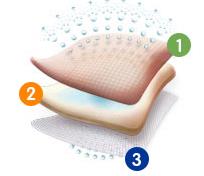Allevyn Non-Adhesive Heel Foam Dressing Features
- Unique triple action technology
- Highly breathable top film
- Non-adherent wound contact layer
- Suitable for use under compression bandaging
- Wide range of sizes that can be cut to suit different body contours
- Fluid is efficiently managed by a unique triple-action technology, resulting in a moist wound environment
- Contact layer ensures it is safe to use on sensitive skin, such as in patients with Epidermolysis Bullosa
Smith & Nephew Allevyn Triple Action Technology

By combining an absorbent hydrocellular pad with a non-adherent wound contact layer and breathable top film, Allevyn Foam Dressing manages fluid to maintain optimal moist wound environment.
- The breathable outer polyurethane top film helps to prevent strikethrough and provides an effective barrier to bacteria
- The highly hydrocellular foam core is highly absorbent
- The wound contact layer will not stick to the wound and is suitable for sensitive skin such as that of patients with Epidermolysis Bullosa
Allevyn Foam Dressing Indications
Shallow, granulating wounds, chronic and acute exudative wounds, full and partial thickness wounds such as pressure ulcers, leg ulcers and diabetic foot ulcers, infected wounds, malignant wounds, surgical wounds, first and second degree burns, donor sites, fungating ulcers, oncological wounds and epidermolysis bullosa wounds.
What to buy with Allevyn Heel Foam Dressing
Allevyn Non-Adhesive Dressing Application
- Cleanse wound in accordance with local clinical protocols
- Select an appropriate dressing size. Allevyn Dressing can be cut to fit awkward areas. Always use a clean technique when cutting the dressing. When used under compression therapy, the dressing must be cut to the size of the wound.
- Prepare and clean the skin surrounding the wound area and remove excess moisture. Any excess hair should be clipped to ensure close approximation to the wound.
- Remove dressing from the pack using a clean technique
- Apply the white face to the wound ensuring good contact and secure with a dressing retention sheet, tape or bandage
- If the dressing has been cut, ensure any exposed foam areas are covered with an appropriate film dressing, taking care not to cover the entire dressing
How to remove Allevyn Dressing?
- To remove Allevyn Non-Adhesive, remove the retention dressing or bandage and lift the dressing away from the wound.
Allevyn Frequency of Change
- During the early stages of wound management dressing should be inspected according to local clinical protocol. Where the product is used on infected wounds, the infection should be inspected and treated as per local clinical protocol.
- Dressings can be left in place, undisturbed, for up to 7 days, or until exudate is visible and approaches 5/8 of an inch (1.5cm) from the edge of the dressing, whichever is sooner.
- If dressings are applied to the sacral area, they may be left in place for up to 5 days. However, due to the increased potential for contamination and infection in this area, increased monitoring of dressing adherence may be required as per local clinical protocols.
- The decision of when to change should be dependent upon clinical assessment and local protocols should also be taken into consideration.
Precautions to take while using Allevyn Heel Non Adhesive Dressing
Do not use Allevyn Non-Adhesive with oxidizing agents such as hypochlorite solutions or hydrogen peroxide, as these can break down the absorbent polyurethane component of the dressing. If reddening or sensitization occurs, discontinue use and consult a healthcare professional. Allevyn Heel must not be used for pressure relief independently of pressure-relieving devices. Allevyn Non-Adhesive is a single-use product. If used on more than one patient, cross-contamination or infection may occur. Opening the dressing pack compromises the sterile barrier therefore any unused dressing should not be retained for use at a later date.
Allevyn Non-Adhesive Heel Foam Dressing User Manual